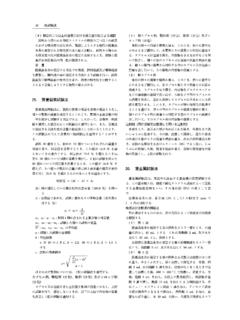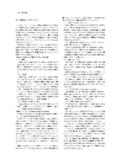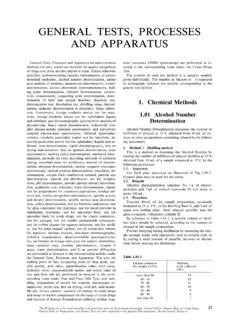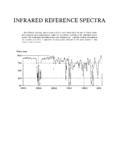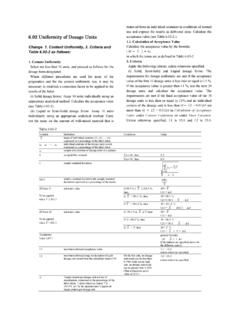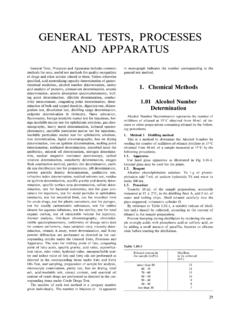Transcription of Pyrrolnitrin - NIHS
1 13251325JP XVIO fficial monographs /Quinapril Hydrochloridefire, and preferably in a cold C10H6Cl2N2O2 (3-chloro-2-nitrophenyl)pyrrole[1018-71- 9] Pyrrolnitrin contains not less than 970mg (potency)and not more than 1020mg (potency) per mg, calcu-lated on the dried basis. The potency of Pyrrolnitrinis expressed as mass (potency) of Pyrrolnitrin (C10H6Cl2N2O2).DescriptionPy rrolnitrin occurs as yellow to yellow-brown,crystals or crystalline is freely soluble in methanol and in ethanol (95), andpractically insoluble in (1)Determine the absorption spectrum of asolution of Pyrrolnitrin in ethanol (95) (1 in 100,000) as di-rected under Ultraviolet-visible Spectrophotometry< >,and compare the spectrum with the Reference Spectrum orthe spectrum of a solution of Pyrrolnitrin RS prepared in thesame manner as the sample solution: both spectra exhibitsimilar intensities of absorption at the same wavelengths.(2)Determine the infrared absorption spectrum of Pyr-rolnitrin as directed in the potassium bromide disk methodunder Infrared Spectrophotometry< >, and compare thespectrum with the Reference Spectrum or the spectrum ofPyrrolnitrin RS: both spectra exhibit similar intensities ofabsorption at the same wave point< >124 1289 CPurityRelated substances Dissolve g of Pyrrolnitrinin 10 mL of methanol, and use this solution as the sample so-lution.
2 Pipet 1 mL of the sample solution, and add methanolto make exactly 100 mL. Pipet 3 mL of this solution, addmethanol to make exactly 10 mL, and use this solution as thestandard solution. Perform the test with these solutions asdirected under Thin-layer Chromatography< >. Spot 10mL each of the sample solution and standard solution on aplate of silica gel for thin-layer chromatography. Developthe plate with a mixture of xylene, ethyl acetate and formicacid (18:2:1) to a distance of about 10 cm, and dry the plateat 809C for 30 minutes. Spray evenly diluted sulfuric acid (1in 3) on the plate, and heat at 1009C for 30 minutes: the spotother than the principal spot obtained from the sample solu-tion is not more intense than the spot from the standard on drying< >Not more than (1 g, reducedpressure not exceeding kPa, 609C, 3 hours).Residue on ignition< >Not more than (1 g).AssayConduct this procedure using light-resistant accurately an amount of Pyrrolnitrin and PyrrolnitrinRS, equivalent to about 50 mg (potency) each, and dissolveseparetely in diluted acetonitrile (3 in 5) to make exactly 50mL.
3 Pipet 10 mL each of these solutions, add exactly 10 mLof the internal standard solution, add diluted acetonitrile (3in 5) to make 100 mL, and use these solutions as the samplesolution and standard solution. Perform the test with 5mLeach of the sample solution andstandard solution as directedunder Liquid Chromatography< >according to the fol-lowing conditions, and calculate the ratios,QTandQS,ofthe peak area of Pyrrolnitrin to that of the internal [mg (potency)] of C10H6Cl2N2O2 MS QT/QS 1000MS: Amount [mg (potency)] of Pyrrolnitrin RSInternal standard solution A solution of benzyl benzoate indiluted acetonitrile (3 in 5) (3 in 500).Operating conditions Detector: An ultraviolet absorption photometer (wave-length: 254 nm).Column: A stainless steel column 4 mm in inside diameterand 15 cm in length, packed with octylsilanized silica gel forliquid chromatography (5mm in particle diameter).Column temperature: A constant temperature of phase: A mixture of water and acetonitrile (11:9).
4 Flow rate: Adjust the flow rate so that the retention timeof Pyrrolnitrin is about 9 suitability System performance: When the procedure is run with 5mLof the standard solution under the above operating condi-tions, Pyrrolnitrin and the internal standard are eluted in thisorder with the resolution between these peaks being not lessthan repeatability: When the test is repeated 6 timeswith 5mL of the standard solution under the above operatingconditions, the relative standard deviation of the ratios ofthe peak area of Pyrrolnitrin to that of the internal standardis not more than and storageContainers Tight Hydrochloride : (3S)-2-((2S)-2-{[(1S)-1-Ethoxycarbonyl-3 -phenylpropyl]amino}propanoyl)-1,2,3,4-t etrahydroisoquinoline-3-carboxylic acid monohydrochloride[82586-55-8]Quinapril Hydrochloride contains not less not more than XVIQ uinapril Hydrochloride Tablets/Official MonographsHCl, calculated on the anhydrous Hydrochloride occurs as a is very soluble in methanol, freely soluble in water andin ethanol ( ), and solubleinaceticacid(100).
5 It is (1)Determine the absorption spectrum of asolution of Quinapril Hydrochloride in methanol (1 in 2000)as directed under Ultraviolet-visible Spectrophotometry< >, and compare the spectrum with the Reference Spec-trum: both spectra exhibit similar intensities of absorption atthesamewavelengths.(2)Determine the infrared absorption spectrum ofQuinapril Hydrochloride as directed in the potassium chlo-ride disk method under Infrared Spectrophotometry< >,and compare the spectrum with the Reference Spectrum:both spectra exhibit similar intensities of absorption at thesame wave numbers.(3)A solution of Quinapril Hydrochloride (1 in 20) re-sponds to the Qualitative Tests< >for rotation< >[a]20D: ( g, calcu-lated on the anhydrous basis, methanol, 25 mL, 100 mm).Purity (1)Heavy metals< > Proceed with g ofQuinapril Hydrochloride according to Method 2, and per-form the test. Prepare the control solution with mL ofStandard Lead Solution (not more than 20 ppm).
6 (2)Related substances Dissolve 50 mg of Quinapril Hy-drochloride in 50 mL of a mixture of phosphate buffer solu-tion, pH and acetonitrile for liquid chromatography(1:1), and use this solution as the sample solution. Pipet 1mL of the sample solution, add a mixture of phosphatebuffer solution, pH and acetonitrile for liquid chroma-tography (1:1) to make exactly 200 mL, and use this solutionas the standard solution. Perform the test with exactly 10mLeach of the sample solution and standard solution as directedunder Liquid Chromatography< >according to the fol-lowing conditions. Determineeach peak area by the auto-matic integration method: the area of the peaks, having therelative retention time of about and about toquinapril, obtained from the sample solution are not largerthan the peak area of quinapril from the standard solution,respectively, the area of peak other than quinapril and abovementioned peak from the sample solution are not larger than2/5 times the peak area of quinapril from the standard solu-tion, and the total area of the peaks other than quinaprilfrom the sample solution is not larger than 3 times the peakarea of quinapril from the standard conditions Detector: An ultraviolet absorption photometer (wave-length: 214 nm).
7 Column: A stainless steel column 6 mm in inside diameterand 15 cm in length, packed with octadecylsilanized silica gelfor liquid chromatography (5mminparticlediameter).Column temperature: A constant temperature of phase: While keeping the temperature not below259C, adjust to pH of mol/L potassium dihydrogenphosphate TS with perchloric acid. To 1000 mL of this solu-tion add 1000 mL of acetonitrile for liquid rate: Adjust the flow rate so that the retention timeof quinapril is about 7 span of measurement: About 4 times as long as theretention time of quinapril, beginning after the solvent suitability Test for required detectability: Pipet 10 mL of the stand-ard solution, and add a mixture of phosphate buffer solu-tion, pH and acetonitrile forliquid chromatography (1:1)to make exactly 100 mL. Confirm that the peak area ofquinapril obtained with 10mL of this solution is equivalentto 7 to 13zof that with 10mL of the standard performance: When the procedure is run with 10mL of the standard solution under the above operating con-ditions, the number of theoretical plates and the symmetryfactor of the peak of quinapril are not less than 5000 and notmore than , repeatability: When the test is repeated 6 timeswith 10mL of the standard solution under the above operat-ing conditions, the relative standard deviation of the peakarea of quinapril is not more than (3)Residual solvent Being specified < >Not more than ( g, coulometrictitration).
8 Residue on ignition< >Not more than (1 g).AssayStart to titrate within 3 minutes after dissolvingQuinapril Hydrochloride. Weigh accurately about g ofQuinapril Hydrochloride, dissolve in 70 mL of acetic acid(100), add 4 mL of bismuth nitrate TS, and titrate< >with mol/L perchloric acid VS(potentiometric titration).Perform a blank determination in the same manner, andmake any necessary mL of mol/L perchloric acid VS mg of and storageContainers Tight In a cold Hydrochloride Tablets Quinapril Hydrochloride Tablets contain not lessthan not more than the labeledamount of quinapril hydrochloride ( ).Method of preparationPrepare as directed under Tablets,with Quinapril a quantity of powdered Quinapril Hydro-chloride Tablets, equivalent to 20 mg of Quinapril Hydro-chloride according to the labeled amount, add 10 mL ofmethanol, shake for 5 minutes, and centrifuge. To 5 mL ofthe supernatant liquid add mL of dilute hydrochloricacid, and add methanol to make 20 mL.
9 Determine the ab-sorption spectrum of this solution as directed under Ultravi-olet-visible Spectrophotometry< >: it exhibits maxima be-tween 256 nm and 260 nm, between 262 nm and 266 nm, andbetween 269 nm and 273 an amount of the supernatant liquid obtained inthe Assay add a mixture of phosphate buffer solution, and acetonitrile for liquid chromatography (1:1) so that13271327JP XVIO fficial monographs /Quinapril Hydrochloride Tabletseach mL contains mg of Quinapril Hydrochloride ac-cording to the labeled amount, and use this solution as thesample solution. Pipet 3 mL of the sample solution, add amixture of phosphate buffer solution, pH and aceto-nitrile for liquid chromatography (1:1) to make exactly 200mL, and use this solution as the standard solution. Performthe test with exactly 10mL each of the sample solution andstandard solution as directed under Liquid Chromatography< >according to the following conditions.
10 Determine eachpeak area by the automatic integration method: the area ofthe peak having the relative retention time of about toquinapril obtained from the sample solution is not largerthan 2 times the peak area of quinapril from the standard so-lution, and the area of the peak, having the relative retentiontime of about to quinapril obtained from the sample so-lution is not larger than the peak area of quinapril from thestandard conditions Proceed as directed in the operating conditions in thePurity (2) under Quinapril suitability System performance: When the procedure is run with 10mL of the standard solution under the above operating con-ditions, the number of theoretical plates and the symmetryfactor of the peak of quinapril are not less than 5000 and notmore than , repeatability: When the test is repeated 6 timeswith 10mL of the standard solution under the above operat-ing conditions, the relative standard deviation of the peakarea of quinapril is not more than of dosage units< >Perform the test accord-ing to the following method: itmeets the requirement of theContent uniformity 1 tablet of Quinapril Hydrochloride Tablets add 3V/5 mL of a mixture of phosphate buffer solution, pH acetonitrile for liquid chromatography (1:1), shakevigorously to disintegrate the tablet, shake again for 10minutes, add a mixture of phosphate buffer solution, pH acetonitrile for liquid chromatography (1:1) to makeexactlyVmL so that each mL contains about mg ofquinapril hydrochloride ( ), and 15 mL of the supernatant liquid, add exactly 2 mL ofthe internal standard solution, add a mixture of phosphatebuffer solution, pH and acetonitrile for liquid chroma-tography (1.)

